Caiman Hunt!
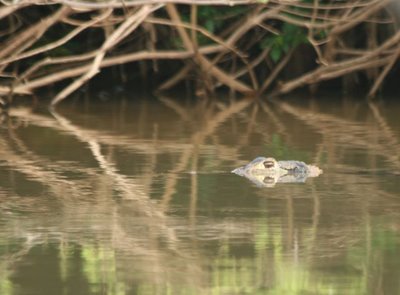
This is about all you ever see of a wild caiman--a pair of eyes looking at you, then slowly submerging.
After my experience with the giant anteater, I was feeling iffy about one of the activities booked for us on the night of our arrival at Caiman House. We would hunt down a caiman and measure and collect data from it. Well, obviously we faint-hearted writers and artists and photographers wouldn't do it; researchers and assistants would do it while we watched and tried to take pictures in the pitch-black night. I came very close to saying no, no thank you, I would rather see a caiman minding its own business. I fought with myself all through dinner, then realized that if I was ever going to learn more about caimans, this would be the time. You have to live life as big as you can, or not much happens.
They pronounce it Kye-mon (rhymes with sky).
Most of us think of caimans as "baby alligators," and many of us probably remember when they were offered as new hatchlings in pet shops. God, what a horrible thing that was, but I remember friends who kept small, sickly tan "baby alligators" in little fishtanks in their homes. File under WHAT WERE WE THINKING? The black caiman is not a baby alligator. It is a huge beast, a crocodilian to be reckoned with. Not as dangerous as a croc or an alligator, but not to be messed with, either. And thank goodness they're no longer being exploited for the pet (slow death in captivity) trade. Although I still see quite a few, stuffed with straw and shellacked, lined up on store shelves, shaking maracas and playing marimbas in the Latin American tourist traps. Bleh.
What was happening here was a caiman capture. Researchers, armed with long catchpoles and nooses, big hanging scales and measuring devices, would attempt to noose an adult caiman, determine if they'd seen it before (using a scale-clipping code that identifies the animal), weigh, measure and sex it, then release it. We were warned that, in order to tire the animal out and render it tractable, they would fight it as they would a game fish for quite some time before attempting to handle it.
It turns out that this is the best way to deal with large caimans. It's not safe to tranquilize the animal because we don't know much about dosages, and because there are a lot of other caimans around looking to climb the caiman social ladder, releasing a caiman that's groggy could result in drowning, maiming and death for the study animal. And it's not safe to try to handle a fresh, snappy caiman, so this is the method they've arrived at as safest both for animal and researchers.
So, tired from a full day of Karanambu and river birding and hiking to Caiman house, we piled into boats and went looking for a big caiman to catch. I was already fretting because I didn't know how I was going to photograph the action in total darkness. I shouldn't have worried. First look at the beast, hauled from the deep.
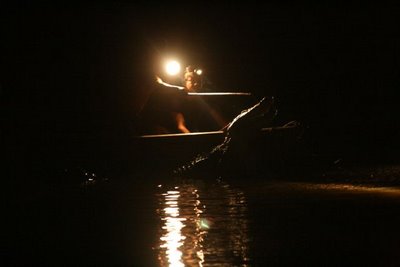 Oh my gosh. Can it really be that big?
Oh my gosh. Can it really be that big?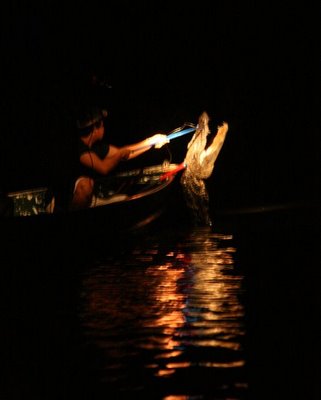
Agggh! Look at that THING! It is HUMONGOUS!
I mentioned fighting the animal to play its strength out. I had plenty of time during the tussle to experiment with different ISO's and apertures, flash or no flash. My favorite pictures were made in ambient torch light (we in the boat had flashlights trained on the action). I love this slow-shutter shot.
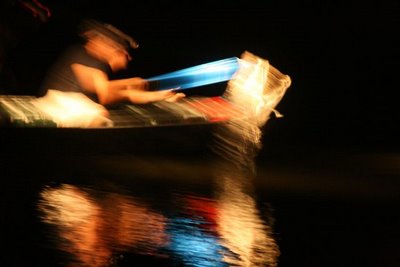
When the caiman would go quiet, I could get some that were almost sharp. Was it a crocodilian, or a fire-breathing dragon they had? Oh, oh oh, these are for you, Timmo.
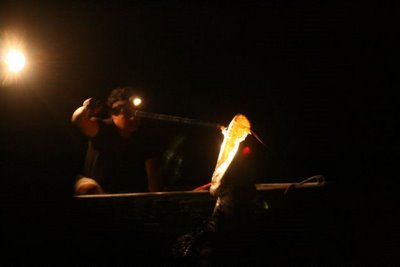 It was as if her rage shone from her jaws.
It was as if her rage shone from her jaws.The lizard wranglers had made an unfortunate catch, looping the noose around the caiman's upper jaw instead of around the whole head or neck. So much of the maneuvering was trying to get its mouth closed and another noose around the jaws. That would be key to handling it safely. I really like this shot. The flash is illuminating the scene just enough to freeze the action, but not enough to burn out the colors and chiaroscuro.
The caiman is surrendering.
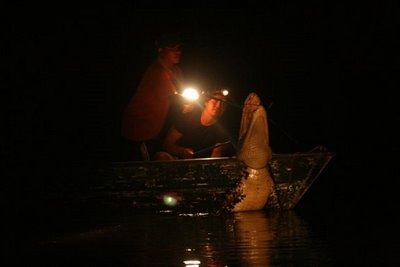 I have to go lie down now. More anon.
I have to go lie down now. More anon.Labels: black caiman, catching a caiman, Guyana South America, Zick's Most Excellent Adventure





